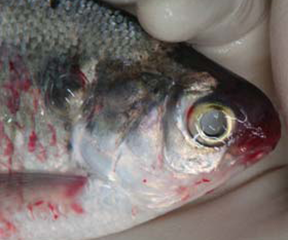Host Interactions
Any bacterium that has a parasitic interaction with another
organism is classified as a pathogen. Just like
tetanus,
C. difficile, and
Leprosy, Aeromonas hydrophila is also
classified as a pathogen to several organisms. In fact, it is
the most common pathogen associated with fish illness.
However, because it is an opportunistic pathogen, Aeromonas hydrophila holds a greater risk of
infection in
hosts when the immune system is poorly functioning.
This could be due to sudden
 environmental change or instability
(changing seasons), if the host is of young or old age, if the
host is infected with another bacteria or virus (including
HIV/AIDS), or because of immune suppressant medications. It also
becomes a greater risk when a host is exposed to contaminated
water or consumes food that has been exposed to contaminated
water. Therefore, aquatic organisms, such as fish and frogs,
have a much higher rate of infection and their degree of
infection tends to be more severe compared to humans. However,
unlike
streptococcus, it is not a normal inhabitant of these host
organisms, yet it has been found in feces of asymptomatic
individuals, a topic further discussed in the next page on
public health.
environmental change or instability
(changing seasons), if the host is of young or old age, if the
host is infected with another bacteria or virus (including
HIV/AIDS), or because of immune suppressant medications. It also
becomes a greater risk when a host is exposed to contaminated
water or consumes food that has been exposed to contaminated
water. Therefore, aquatic organisms, such as fish and frogs,
have a much higher rate of infection and their degree of
infection tends to be more severe compared to humans. However,
unlike
streptococcus, it is not a normal inhabitant of these host
organisms, yet it has been found in feces of asymptomatic
individuals, a topic further discussed in the next page on
public health.
Once the bacteria enter the host, it attaches to the eukaryotic
cell via pili and adhesions. The bacterial envelope can then
fuse with the cell membrane and thus activating the T2SS, T3SS, and T6SS as discussed in the
adaptation section. The signals that the bacteria receive
once inside its host trigger it to colonize and secrete toxins.
The virulence factors that it creates force the host's cells to
benefit the bacteria rather than the host, making this a
parasitic relationship. The bacteria have adapted
polysaccharide capsules to persist and survive despite the
host's immune response. Because of its strong virulence factors
and resistance mechanisms, varying degrees of symptoms occur in
the host.
In fish, it can cause
ulcers, lesions, swelling, bulging eyes or scales (due to the
fluid secretion in the intestines), and hemorrhages on the
exterior of the fish.
Although its prevalence is less common in humans, it can cause a
variety of different infections. It is most known to cause gastroenteritis
in humans which can last for a
couple of days to a couple of weeks in more severe cases.
Symptoms include fever, abdominal cramps, diarrhea, and
dehydration. Although it is resistant to several antibiotics, it
is treatable using strong doses and different combinations of
alternative antibiotics. Additionally, in situations where trauma has caused
a penetrating injury in the skin, Aeromonas hydrophila
can infect the surrounding tissue causing necrotizing faciitis,
myonecrosis, or cellulitis. In such cases, it often becomes severe
enough to require amputation and an observed mortality
rate of 67% was associated with this type of infection. However, as
noted earlier, those infected tend to have previous health
conditions allowing them to be more susceptible to the
infection, and these existing conditions can also be attributed
to such a high mortality rate. In reflection, the pathogenic
interaction that this organism has with its host can range
anywhere from mild to fatal depending on these several determining
factors.
resistant to several antibiotics, it
is treatable using strong doses and different combinations of
alternative antibiotics. Additionally, in situations where trauma has caused
a penetrating injury in the skin, Aeromonas hydrophila
can infect the surrounding tissue causing necrotizing faciitis,
myonecrosis, or cellulitis. In such cases, it often becomes severe
enough to require amputation and an observed mortality
rate of 67% was associated with this type of infection. However, as
noted earlier, those infected tend to have previous health
conditions allowing them to be more susceptible to the
infection, and these existing conditions can also be attributed
to such a high mortality rate. In reflection, the pathogenic
interaction that this organism has with its host can range
anywhere from mild to fatal depending on these several determining
factors.
For more on the occurrence and pathology of the organism, go to
the next page on public
health.
To return to the home page, click
here.